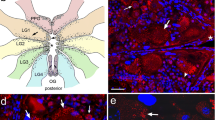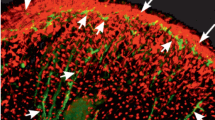Abstract
The medicinal leech possesses FMRFamide-like immunoreactivity in neural processes and somata associated with the pharynx and pharyngeal ganglia. The pharynx possessed about 25 immunoreactive somata; about half of the approximately 20 neurons of the pharyngeal ganglia were immunoreactive. We provide brief descriptions of several neurons located in the first neuromere of the subesophageal ganglion involved in controlling pharyngeal motility. Double-labeling experiments indicate that one of these cells, named Swallow neuron 1 (SW1), contains a FMRFamide-like peptide. Stimulation of SW1 caused the mouth to open and the pharynx to dilate. Upon termination of SW1 stimulation, the mouth closed, and a peristaltic wave progressed from the mouth down the length of the pharynx. Stimulation of SW1 did not produce 1:1 postsynaptic potentials in pharyngeal muscle cells. Thus, SW1 is apparently not a motor neuron. The pharynx responded to application of FMRFamide and related peptides by producing a series of 20- to 35-s phasic contractions superimposed upon an increase in basal tonus. The peptide-induced response was quantified by measuring increases in basal tonus, peak tension, and integrated area. Although there were some differences in the order of potency depending upon which parameter was considered, the approximate order of potency of RFamide peptides tested was: pQDPFLRFamide ≥ FMRFamide ≈ YGGFMRFamide ≥ YMRFamide ≈ FLRFamide ≈ GGKYMRFamide ≈ YLRFamide > leucomyosuppressin ≈ perisulfakinin. Except for differences in potency, each of the RFamide peptides produced similar contractile waveforms. FMRFamide-induced responses were reduced by the protein kinase C inhibitor bisindolylmaleimide I (10 μM), the nonspecific protein kinase inhibitor H-7 (50 μM), and were increased by the protein phosphatase inhibitor okadaic acid (1 μM). However, the FMRFamide-induced response was unaffected by the protein kinase A inhibitor H-89 (1 μM), the phosphodiesterase inhibitor theophylline (1 mM), the phospholipase A2 inhibitor OBAA (0.1 μM) or the cation channel blocker amiloride (100 μM).
Similar content being viewed by others
Author information
Authors and Affiliations
Additional information
Accepted: 7 June 1999
Rights and permissions
About this article
Cite this article
O'Gara, B., Brown, P., Dlugosch, D. et al. Regulation of pharyngeal motility by FMRFamide and related peptides in the medicinal leech, Hirudo medicinalis . Invert Neurosci 4, 0041–0053 (1999). https://doi.org/10.1007/PL00022367
Issue Date:
DOI: https://doi.org/10.1007/PL00022367




